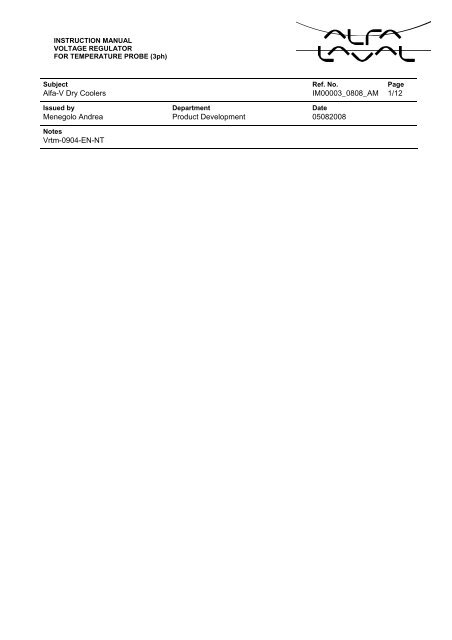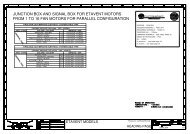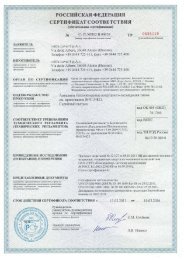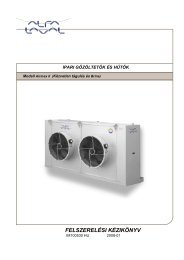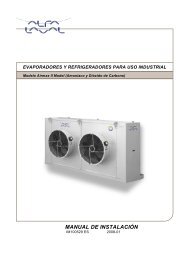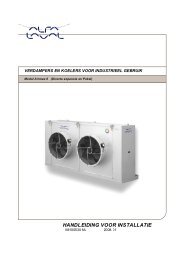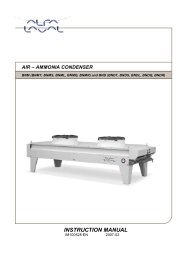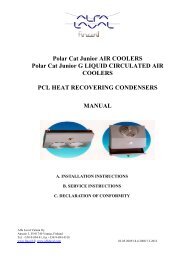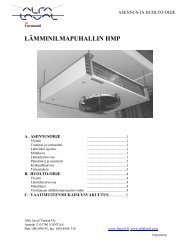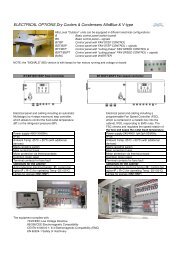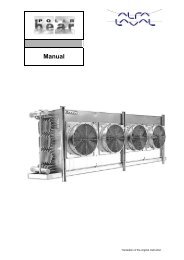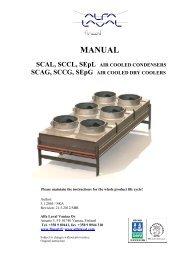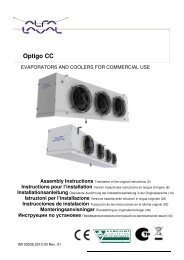Create successful ePaper yourself
Turn your PDF publications into a flip-book with our unique Google optimized e-Paper software.
Position 1 2 3 4 5 6 7CODEVRTM 12 C NT PL 55 V1.3 (code example)Pos. 1 : Regulator mode VRTM = three phase regulatorVRMM = single phase regulatorPos. 2 : Nominal current 12 = 12A / 20 = 20A …Pos. 3 : Power supply A= 230V∼50Hz C= 230/400V∼50Hz D= 440V∼60HzPos. 4 : Probe type PR = pressureNT = temperature NTCPos. 5 : Box PL = plasticMT = aluminiumPos. 6 : IP grade 55 = IP55Pos. 7 : Software version 1.2 (for vers. V1.0 / V1.0st ZTM2NT keyboard)VRTMMODELModel * Power Current Current Power Supply Freq.Max nominal max ** dissipation voltagekW A rms A rms W V~ (+10-15%) HzVRTM12C 4,5/8 12 18 80 230/400V 50VRTM20C 7,5/13 20 30 120 230/400V 50VRTM28C 11/19 28 50 170 230/400V 50VRTM40C 15/26 40 70 260 230/400V 50VRTM50C 18/32 50 70 330 230/400V 50* For VRTMXXD models at 440/460V-60Hz all current and power data are the same** Max current refers to an environment temperature of 50°C for a maximum time of 10seconds every 5 minutes ( In +50%, class 12, 3%).TECHNICAL SPECIFICATIONSPOWER SUPPLY230/400V~ +10%/-15%, (230 V~, 440 V~ on request)FREQUENCY50HzOUTPUT VOLTAGE0-99% of power supplyCONTROL INPUTSOne or two ntc probes (10kohm at 25°C) , or 0...10V=signal.DIGITAL OUTPUTEmerg. relay (1A-250V~/3A-30V=)ANALOGUE OUTPUT 0…10V= (max load 5mA)OPERATING TEMPERATURE -10°C/+50°CSTORAGE TEMPERATURE -20°C/+80°CMAX DISSIPATOR TEMP. 75°CPROTECTION RATING Self-extinguishing plastic covering IP55 for120°C environment, pollution grade 3, fire resistance D,impact resistance (6J).ELECTRIC CLASSIFICATION Class II for control inputs (insulation of 4kV with liveparts). Class I for accessible parts.2
MECHANICALINSTALLATIONThe VRTM regulator must be wall-mounted vertically, in order to guarantee adequatedispersion of heat in the area of air circulation and prevent obstructions to air flow in thedissipator zone. To prevent the formation of condensation and ensure correct operationalso at low temperatures, constant power supply should be ensured (avoiding repeatedshutdowns). Avoid positioning it near heat sources and keep away from direct sunlight.The regulator has IP55 protection rating but must be protected from sprays of water, oil,corrosive liquids, deposits of metallic dust and gas. Also ensure that it is not subject tovibrations.ELECTRICAL INSTALLATIONSAttach the regulator to a non-painted plate with anti-corrosive treatment.If the length of the motor cable exceeds 5 metres, use shielded cable. To avoid dispersioncurrents, both ends of the motor cable shield, the motor earth, and the regulator earthmust be connected to the same earth pole. If the control cable length exceeds 2 metres, useshielded cable, connecting the shield only at the end of the regulator. Ensure that thecontrol 0 volt is not connected to earth.If the length of the power, motor and control cables exceeds 10m, make sure they areseparated by at least 0.3 metres to avoid creating a coupling effect.If controls are set up in environment subject to electromagnetic disturbance, they shouldbe housed inside a suitable metallic enclosure.All connections wires must resist to a 80°C working temperature.Avoid routing any electric wires near the copper coils of the filter, for control cables usethe suitable plastic support !Tighten all wires on control and power terminal boards fully down, avoiding protrusionof the multi-stranded wire.Do NOT touch the electronic equipment when the power line is on !During voltage insulation tests disconnect the regulator power lines In/Out.Use a true RMS tester to measure the current or voltage valuesTerminals Description Recommended wire sections (ISO mm²)VRTM12 VRTM20 VRTM28/40/50EARTH 2,5 4 16L1 L2 L3 SUPPLY 2,5 4 16T1 T2 T3 MOTOR 2,5 4 16(U V W)CONTROLS 0,2÷1,5 0,2÷1,5 0,2÷1,5To connect wiring to the spring terminals, apply leverage with a screwdriver on the leveror on the upper hole to open the terminal. The power wires of the VRTM 28-40 regulatorsmust be crimped to form an eyelet (M5 hole) and the nuts (E8) tightened with a wrench.The power wires of the VRTM 50 regulators must be crimped to form an eyelet (M6 hole)and the nuts (E10) tightened with a wrench. Connect all earth wires, both of the line andmotor(s) to the relative internal terminals on the regulator (see drawings).4
LINE FUSESTo protect the regulator electric power components also in the event of fan short-circuits,the installer/user must provide quick acting type fuses for semiconductors.Model Nominal current Max current Fuse(Arms) (Arms) (A)VRTM12 12 18 16VRTM20 20 30 25VRTM28 28 50 35VRTM40 40 70 63VRTM50 50 70 800V230V40VRTM/T12/20VOLTAGE CHANGEOVEREXPANSION OUTPUTSMOTORSL1/L2/L3/Ground(R / S / T)SUPPLY TERMINALSGround /T1/T2/T3( U / V / W)MOTOR TERMINALSVRTM/T28/40/50230V400VVOLTAGECHANGEOVERL1 L2 L3 PE T3 T2T1( R S T ) ( W VU )SUPPLY TERMINALS / MOTOR TERMINALS5
CONTROL TERMINALSTerminalFunctionDescription1 No Relay contact normally open23ComNcRelay common (1A-250Vac / 3A-30V=)Relay contact normally closed4 0V 0V isolated5 I1 Cooling1 cycle / Cooling2 cycle6 I2 Maximum power control7 I3 Start/stop control8 I4 Input for external emergency (motor thermal cutout)910Ou t0VAnalogue output 0-10V= per control reg. slave0V isolated11 0V 0V isolated12 IN2 Input probe 2 NTC (10kohm at 25°C)1314+15V=0VAuxiliary supply (max100mA)0V isolated15 IN1 Input probe 1 NTC (10kohm at 25°C) or 0-10Vdcimpedance 20KΩ)16 +15V= Auxiliary supply (max100mA)ControlscardALLARMMAX POWER OUTPOWER ONRELAY ONDL1DL2DL3DL4RELAY0VI 1 COOL 1 / COOL2I 2 MAX POWER OUTI 3 START / STOPI 4 STOP EMERGENCYOUT 0...10V0V0VIN 2 Input 2+150VIN 1 Input 1+15S1S2S3S4S5S6S7S8ONOFFMICRO SWITCHES6
RELAY OUTPUTThe relay output can be set via the keyboard as follows (keyboard parameters 217 and 35):Fault = Deactivation of relay (alarm).Motor on = Activation of relay with motor on.Temp. Max = Activation of relay with delivery of maximum temperature.Temp. Min = Activation of relay with delivery of minimum temperature.Cyclical rotation = According to cyclical rotation of the power line phase.WARNING ! In the fault configuration the relay is normally activated, if there is an alarmit deactivates returning to the position shown in the figure on page 6.CONTROLSControl I 1 : Active only if I 3 and I 4 controls are closed and only whilefunctioning as master.Open = cooling cycle 1Closed = cooling cycle 2(if connected to the keyboard ‘RUN1/ RUN2’ will appear on display )Control I 2 : Active only if I 3 and I 4 controls are closed.Max power Open = no control / Closed = if Master config., voltage applied tomotor at set 217 parameter; if Slave config., voltage applied to motorat set 36 parameter, if manual config., voltage applied to motor at set46 parameter.Control I 3 : Always activeStart/stop Open = stop, the regulator is deactivated (if connected to the keyboard‘RDY’ will appear on display)Closed = start, resets the regulator to the pre-chosen function (ifconnected to the keyboard ‘Fan’ will appear on the display)Control I 4 : Always activeEmergency Open = external emergency present, deactivation of the regulatorClosed = no external emergencyANALOGUE OUTPUTInstant output 0…10V= proportional to the output voltage T1/U - T2/V - T3/W of theregulator.ANALOGUE INPUTThe regulator is provided with two analogue inputs which can be used according to thefunctions set via the keyboard (Master or Slave, to see pag.1). While functioning as Masterthe analogue inputs can be used in the following 3 ways (parameter 215):- Probe1 : Use of input 1 only (sensor 1)- Major : Use of inputs 1 and 2 with priority of the higher values (sensor 1, sensor 2)- Minor : Use of inputs 1 and 2 with priority of the lower values (sensor 1, sensor 2)7
Input 1 : Analog input for NTC sensors with 2 wires (10kohm at 25°C) or 0…10Vdc signal.To adapt the probe signal set the keyboard (parameter 214) and set the micro-switches asfollows:Type probe/s S1 S2 S3 S4 S5 S6 S7 S80…10V= off off off off off on on off-30°… +20°C on off off off off on on on-10°… +40°C on on on off off on on on+20°… +70°C on on on on on ono on onInput 2 : Analog input for NTC sensor with 2 wires (10kohm at 25°C).If the regulator is functioning as slave then use input 1 set for sensor 0..10Vdc, DO NOTuse input 2.Examplentc probe/s(Master mode)Input 2Input 10VIN 2+150VIN 1+15S1S2S3S4S5S6S7S8ONOFFProbe 2ntcout / -+Probe 1ntcExample0…10V= signal(Slave mode)Input 10VIN 2+150VIN 1+15S1S2S3S4S5S6S7S8ONOFF+-Remote control0...10V= signal8
FAULTS - INDICATORSLED DESCRIPTION (see control board figure on page 6)DL1DL2DL3DL4Lit: indicates regulator fault (general alarm)Lit: indicates regulator at maximum deliveryLit: indicates power supply onLit: indicates relay activatedFAULT DESCRIPTIONSFailure of power supply to turn on, sensor disconnected, external emergency (control 14open), over-heating inside the regulator; these emergencies act on the regulator in thefollowing way:Led DL1 illuminatesDisabling of the output voltage T1/U - T2/V - T3/WResetting to zero of the analogue outputDeactivation of the relay if set for fault (setting of alarm for parameters 217 and 35)Display of the type of emergency if the keyboard is connected: FLT (fault);To check the cause, enter operation display mode (see page 4 ZTM2 keyboard) anduse the arrow key to select the relative item in the drop down menu.Open I3 (start/stop) control or turn off the power supply to reset the regulator.TECHNICAL ASSISTANCEContact FAE assistance explaining clearly the following points:• Regulator model• Serial number (pag.1)• Problem encounteredDISMANTLINGOnce the regulator is reported as defective it must be delivered to the nearest servicedepartment. It can be partially recycled due to its plastic and metallic parts.The electronic boards cannot be recycled.9
PROGRAMFILE ___________ DEFAULT V1.2Configuration11) Mode __________ masterMaster general211) Skip voltage __________ 50%212) Skip window __________ 0%213) Reg. ramp. __________ 5 s214) Probe range __________ -10 +40°C215) Probe config. __________ probe 1216) Config. relay __________ defect (emergency)217) Max voltage __________ 100%Master cycle 1221) Voltage V1 __________ 35%222) Temperature T1 __________ 12°C223) Voltage V2 __________ 80%224) Temperature T2 __________ 35°C225) Temp. TOFF __________ 11°C226) Temp. TMAX __________ 37°CMaster cycle 2231) Voltage V1 __________ 35%232) Temperature T1 __________ 10°C233) Voltage V2 __________ 80%234) Temperature T2 __________ 28°C235) Temp. TOFF __________ 9°C236) Temp. TMAX __________ 29°CSlave31) Reg. ramp __________ 5 s32) Voltage VOFF __________ 35%33) Skip voltage __________ 50%34) Skip window __________ 0%35) Config. relay __________ defect (emergency)36) Max voltage __________ 100%10


